For the 2025 school year, there are 3 public elementary schools serving 1,795 students in Gainesville Independent School District. This district's average elementary testing ranking is 1/10, which is in the bottom 50% of public elementary schools in Texas.
Public Elementary Schools in Gainesville Independent School District have an average math proficiency score of 26% (versus the Texas public elementary school average of 42%), and reading proficiency score of 33% (versus the 52% statewide average).
Minority enrollment is 73% of the student body (majority Hispanic), which is less than the Texas public elementary school average of 75% (majority Hispanic).
Overview
This School District
This State (TX)
# Schools
5 Schools
6,902 Schools
# Students
3,088 Students
3,737,053 Students
# Teachers
201 Teachers
255,471 Teachers
Student : Teacher Ratio
15:1
15:1
District Rank
Gainesville Independent School District, which is ranked #972 of all 1,196 school districts in Texas (based off of combined math and reading proficiency testing data) for the 2021-2022 school year.
The school district's graduation rate of 95% has increased from 90-94% over five school years.
Overall District Rank
#966 out of 1204 school districts
(Bottom 50%)
(Bottom 50%)
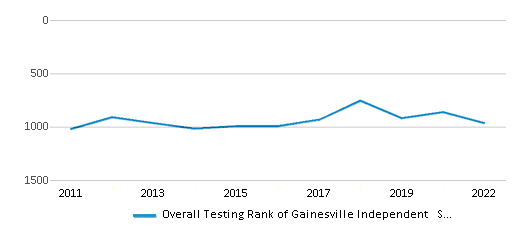
Math Test Scores (% Proficient)
31%
41%

Reading/Language Arts Test Scores (% Proficient)
37%
51%
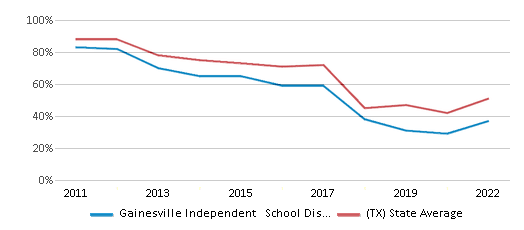
Science Test Scores (% Proficient)
37%
46%
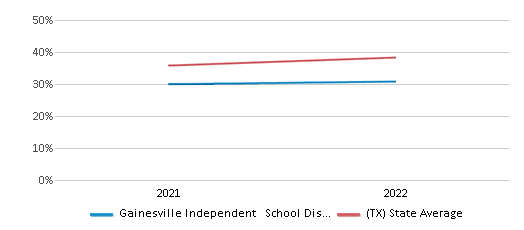
Graduation Rate
95%
90%
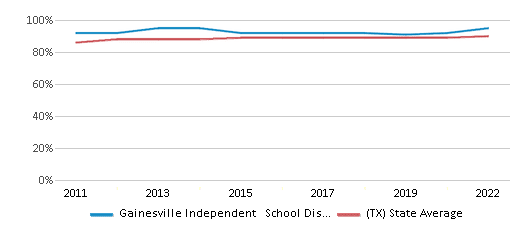
Students by Ethnicity:
Diversity Score
0.54
0.64
# American Indian Students
15 Students
11,705 Students
% American Indian Students
1%
n/a
# Asian Students
31 Students
203,767 Students
% Asian Students
1%
6%
# Hispanic Students
1,917 Students
1,997,454 Students
% Hispanic Students
62%
53%
# Black Students
131 Students
469,194 Students
% Black Students
4%
13%
# White Students
821 Students
924,841 Students
% White Students
27%
25%
# Hawaiian Students
4 Students
5,879 Students
% Hawaiian Students
n/a
n/a
# Two or more races Students
169 Students
124,213 Students
% of Two or more races Students
5%
3%
Students by Grade:
# Students in PK Grade:
168
222,501
# Students in K Grade:
227
346,866
# Students in 1st Grade:
223
385,427
# Students in 2nd Grade:
241
402,148
# Students in 3rd Grade:
250
399,623
# Students in 4th Grade:
223
398,690
# Students in 5th Grade:
256
399,071
# Students in 6th Grade:
207
402,143
# Students in 7th Grade:
210
335,034
# Students in 8th Grade:
211
339,814
# Students in 9th Grade:
249
32,833
# Students in 10th Grade:
230
28,116
# Students in 11th Grade:
226
23,862
# Students in 12th Grade:
167
20,925
# Ungraded Students:
-
-
District Revenue and Spending
The revenue/student of $12,728 in this school district is less than the state median of $13,387. The school district revenue/student has stayed relatively flat over four school years.
The school district's spending/student of $11,137 is less than the state median of $14,116. The school district spending/student has stayed relatively flat over four school years.
Total Revenue
$39 MM
$74,029 MM

Spending
$34 MM
$78,063 MM
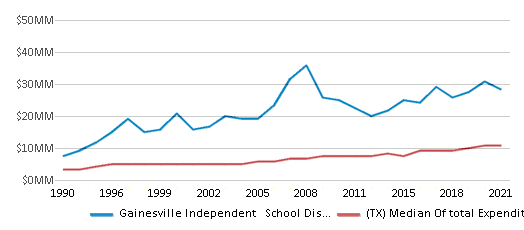
Revenue / Student
$12,728
$13,387
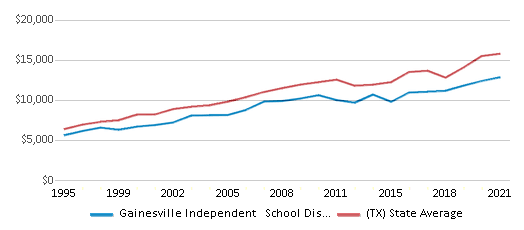
Spending / Student
$11,137
$14,116
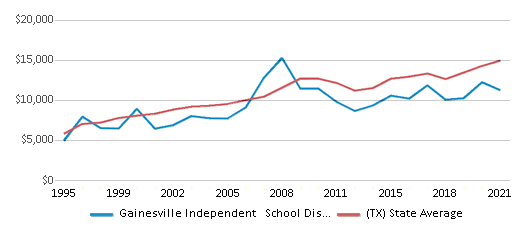
Best Gainesville Independent School District Public Elementary Schools (2025)
School
(Math and Reading Proficiency)
(Math and Reading Proficiency)
Location
Grades
Students
Rank: #11.
Gainesville Intermediate School
(Math: 28% | Reading: 31%)
Rank:
Rank:
2/
Bottom 50%10
2100 N Grand Ave
Gainesville, TX 76240
(940) 668-6662
Gainesville, TX 76240
(940) 668-6662
Grades: 5-6
| 463 students
Rank: #22.
W E Chalmers Elementary School
(Math: 25% | Reading: 34%)
Rank:
Rank:
2/
Bottom 50%10
600 Fm 3092
Gainesville, TX 76240
(940) 665-4147
Gainesville, TX 76240
(940) 665-4147
Grades: 2-4
| 714 students
Rank: n/an/a
1 Edison Dr
Gainesville, TX 76240
(940) 665-6091
Gainesville, TX 76240
(940) 665-6091
Grades: PK-1
| 618 students
Recent Articles

Sexual Harassment at Age 6: The Tale of a First Grade Suspension
A six-year old in Aurora, Colorado, was suspended after singing an LMFAO song to a little girl in his class and reportedly “shaking his booty.” We look at the case and the sexual harassment problem in public schools today.

How Scaffolding Could Change the Way Your Child Learns
This article explores the concept of instructional scaffolding, a teaching method that enhances learning by breaking down complex tasks into manageable parts. It highlights how scaffolding supports students in developing critical thinking skills and becoming more independent learners. The article discusses the benefits of scaffolding, including improved engagement and reduced anxiety, and provides strategies for its implementation across various educational levels.

February 05, 2025
Understanding the U.S. Department of Education: Structure, Impact, and EvolutionWe explore how the Department of Education shapes American education, from its cabinet-level leadership to its impact on millions of students, written for general audiences seeking clarity on this vital institution.





